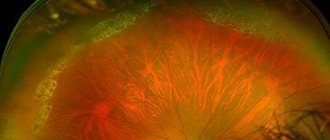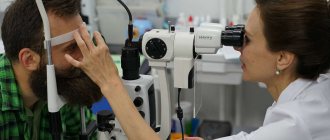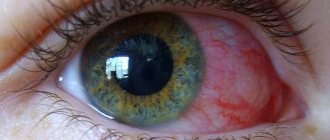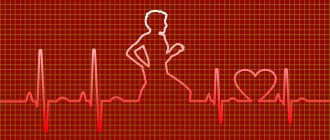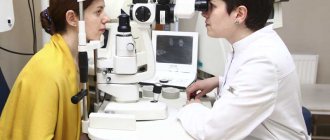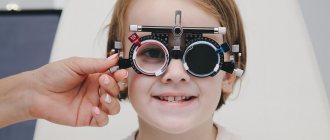In this article we will tell you:
- Types of eye angiopathy
- Causes of angiopathy
- Symptoms and diagnosis of angiopathy
- Angiopathy during pregnancy
- Treatment of angiopathy
- Prevention of angiopathy
- conclusions
Angiopathy of the retina cannot be called an independent diagnosis - rather, it is a pathological condition, a symptom. It occurs as a result of other diseases that specifically affect the blood vessels of the retina. And not only her, but the whole body. Typically, retinal vascular angiopathy in an adult is diagnosed after the age of 30. As soon as nervous regulation is disrupted, the vessels undergo negative changes.
Types of eye angiopathy
Angiopathy is not a separate disease, but evidence of the development of other diseases of the body that affect blood vessels, including disrupting the blood circulation of the retina. But retinal angiopathy cannot be ignored, as it can lead to very dangerous consequences for the body, including complete loss of vision.
The variety usually indicates the disease that caused its appearance. She may be:
- Traumatic, which can potentially develop against the background of increased intracranial pressure. It is provoked by injuries to the neck, brain, and compression of the chest.
- Hypertensive. Hypertension is often its cause. Arterial hypertension affects target organs, one of which is the eyes. Against this background, hypertensive retinal angiopathy is rapidly developing. The blood vessels of the fundus narrow unevenly, and venous branching appears. When the retina is damaged by the hypertensive type, visual acuity is significantly reduced. If you have had a critical increase in blood pressure (hypertensive crisis) or have experienced a change in systolic pressure that is not amenable to medication, check your vision and intraocular pressure just in case.
- Diabetic, when changes in the retina provoke diabetes mellitus and impaired glucose metabolism.
- Macroangiopathy and microangiopathy. In the first case, large vessels of the eye are affected, in the second, the capillary walls become thinner and hemorrhage begins in the eye tissue.
- Hypotonic angiopathy is characterized by dilated arteries and venous pulsation.
- Reduced vascular tone deprives the body of normal blood flow. Blood clots form in the capillaries, causing hemorrhage in the eyeball and retina.
- Background damage to blood vessels. It is characterized by the development of degeneration of its membrane against the background of various intoxications, vascular lesions and other diseases.
- Venous angiopathy occurs due to the formation of stagnation in the blood.
- Blood clots and hemorrhages form directly in the eyeball. Blurred vision and progressive myopia are a consequence of venous dilations.
- Juvenile angiopathy (Eales disease) occurs before the age of 30.
The disease is often associated with tuberculosis, toxoplasmosis and other infections. Inflammatory vascular changes begin in the fundus of the eye with disruption of the blood supply to the retina.
Forecast
The prognosis for angiopathy depends on the timeliness of treatment of the underlying disease. Under this condition, processes can be stopped and complications can be prevented. If diabetes mellitus is compensated (that is, the blood glucose level is maintained within the normal range acceptable for a patient with diabetes mellitus), vascular disorders do not progress, or at least do not progress so rapidly.
Stabilization of blood pressure stops the progression of hypertensive angiopathy, but altered and sclerotic vessels do not restore their function. In the traumatic form of vascular pathology, active treatment of the consequences of injury and periodic preventive courses of vascular therapy can improve the condition of the fundus. Vascular changes aggravated by gestosis in pregnant women are gradually eliminated within 2 years after childbirth with adequate treatment, which distinguishes this form of angiopathy from hypertensive one. Juvenile angiopathy of all forms has a poor prognosis and is prone to progression, which ultimately leads to significant vision loss.
Causes of angiopathy
Changes in retinal vessels can be caused by various reasons. This pathology develops differently and is the object of study not only by an ophthalmologist, but also by other doctors, such as a neurologist, endocrinologist, etc. This is due to the fact that in the eye the veins and arteries of the retina are accessible for observation, unlike the blood supply to other human organs .
There is a huge list of reasons leading to the development of angiopathy in both eyes. Here are just some of the causes of retinal angiopathy:
- Diabetes.
- Smoking.
- Blood diseases.
- Osteochondrosis of the cervical spine.
- Arterial or intracranial hypertension.
- Diseases of the nervous system.
- Hypotension or hypertension.
- Autoimmune diseases.
- Injuries.
- Heredity.
- Elderly age.
All changes impair the nutrition of the retina, resulting in oxygen starvation.
Symptoms and diagnosis of angiopathy
As a rule, angiopathy is associated with the quality of vision. As soon as you notice that your sharpness has sharply decreased, “floaters” or “sparks” begin to appear in your eyes, the picture seems foggy and cloudy - immediately contact an ophthalmologist. The clinical picture may also be accompanied by unpleasant symptoms:
- Darkening in the eyes.
- Nose bleed.
- Deterioration of vision.
- Headache.
- Periodically occurring blur of objects.
- Sensation of pulsation in the eyes after intense visual work.
The problem is that in many cases, retinal vascular angiopathy manifests itself rather sluggishly at the initial stage. Therefore, some people are unaware of their problem, although patients feel that their vision has deteriorated. Over time, if retinal angiopathy is not eliminated, gradual rejection of retinal tissue and their necrosis will begin, resulting in complete loss of vision.
Examination of the fundus is considered one of the most reliable methods for diagnosing angiopathy. The ophthalmologist observes changes in the lumens of blood vessels and their passages. In more complex situations, when serious changes occur in the retina or optic nerve head, additional diagnostic methods are needed:
- Ultrasound scanning of the eyes.
- Computer study of the boundaries of the field of view.
- Diagnostic examination using beam.
Damage to the blood vessels of the eye can occur in people of any age, but most often occurs after 30 years of age.
Complications of the disease are expressed in optic nerve atrophy, narrowing of the visual field, loss of vision (partial, complete). There is a classification of diseases that cause retinal angiopathy. Accordingly, for effective treatment it is necessary to make an accurate diagnosis and find the cause that led to circulatory disorders.
Angiopathy during pregnancy
Since in pregnant women the blood volume increases several times with the growth of the fetus, the blood vessels increase accordingly. Changes in the circulatory system cause angiopathy in pregnant women. Additionally, it is provoked by a hormonal factor, which is observed in the first trimester. In the second and third trimester, a decrease in peripheral vascular resistance occurs due to the functioning of the uteroplacental circulatory system. Another reason that can provoke angiopathy in pregnant women is gestosis. Detection of such a pathology in pregnant women carries risks, since the use of many drugs is not allowed in this situation. In some cases where there is a risk of retinal detachment, the doctor may recommend a cesarean section.
List of used literature
- Babaeva A.R., Tarasov A.A., Davydov S.I., Emelyanova A.L. // Bulletin of VolSMU. - 2006. - T. 19, No. 3. - P. 18-23.
- Voskanyants A. N., Nagornev V. A. // Cytokines and inflammation. - 2004. - T. 3, No. 4. - P. 10-13.
- Gurevich V.S. // Diseases of the heart and blood vessels. - 2006. - No. 4. - P. 4-8.
- Demyanov A.V., Kotov A.Yu., Simbirtsev A.S. // Cytokines and inflammation. - 2003. - T. 2, No. 3. - P. 20-35.
- Dedov I.I., Aleksandrov A.A. // Consilium med. — 2004. —T. 6, No. 9. - P. 620-624.
- Dedov I. I., Antsiferov M. B., Galstyan G. R., Tokmakova A. Yu. Diabetic foot syndrome. — M.: Federal Diabetology Center of the Ministry of Health of the Russian Federation, 1998
Treatment of angiopathy
Various methods are used in the treatment of retinal angiopathy. Therefore, it is important to understand exactly what form of the disease arose. After identifying the main cause, therapy is prescribed, aimed primarily at its correction, and the following are prescribed as auxiliary measures:
- Medications, eye drops.
- A low-calorie diet with limited simple carbohydrates and salt.
- Physiotherapeutic procedures.
- Massage of the cervical-collar area.
To prevent the appearance of angiopathy or delay its progression in case of damage to the ocular vessels, it is recommended to consult a specialist in a timely manner. Early initiation of treatment guarantees a favorable prognosis. If you have any chronic diseases or symptoms of visual impairment, do not delay visiting an ophthalmologist. Proper treatment and improved lifestyle can delay the development of the disease for a long time.
Medicines
If the problem of treating the underlying disease is solved, drugs such as pentoxifylline (Pentyline), Trental, Vazonit (help to improve blood flow) are used in treatment.
Xanthinol nicotinate and ginkgo biloba preparations (Bilobat, Tanakan) improve the condition of the vascular wall. To normalize microcirculation, take vitamins C, A, E, B.
ATP-long, actovegin, cocarboxylase drugs have a metabolic effect: they activate blood circulation and improve metabolism.
Soft antiplatelet agents: Magnicor, dipiradamole prevent the formation of blood clots.
Since all such pathologies seriously affect the quality of life, and in some cases are threatening, drug therapy should be agreed with the attending physician.
Prevention of angiopathy
Treatment is not just about taking medications. It is very important to maintain a proper diet and change your lifestyle. The diet should be low in salt and animal fats, high in potassium and magnesium. The patient should also increase physical activity. If intense exercise is contraindicated for a person, it is necessary to select a set of gymnastic procedures adapted to his activity and capabilities. Sometimes walking or cycling is enough. It is important that the exercises are performed systematically, that is, they are part of your daily routine.
In order for the blood vessels, including the blood vessels of the eyes, to be in normal condition, it is important to follow simple rules:
- Do not abuse alcohol, get rid of nicotine addiction.
- Prevent the development of hypertension, diabetes and other provocateurs of hypertensive angiopathy.
- Periodically undergo courses of treatment if the disease is chronic.
- Carry out a preventive examination every year, even if there are no obvious vision problems.
- When angiopathy is detected in pregnant women, in order to avoid retinal detachment, a cesarean section is recommended.
The eyes are an important organ, without which a person would not be able to receive information from the outside world. Retinal angiopathy can deprive a person of a normal life and make him disabled. Therefore, any visual impairment, even minor, must be accurately diagnosed and corrected in an ophthalmology clinic. And serious diseases - diabetes and hypertension - must be constantly monitored.
conclusions
A change in the nervous regulation of retinal vessels, leading to their weakness (relaxation) or spasm. Blood supply processes are disrupted, as a result of which vision suffers. The causes are usually other diseases: diabetes mellitus, the development of hypertension (essential hypertension). As well as spinal and brain injuries. If angiopathy is detected at the initial stage, its further development can be prevented. Lack of timely treatment is fraught with the development of dangerous complications, for example, retinoschisis. The main methods of treating retinal angiopathy are medications and surgery. It is necessary to periodically visit an ophthalmologist for a preventive examination, since the pathology usually does not manifest itself in the initial stages.
Treatment depends on the type of disease. It should be timely and aimed at getting rid of the root cause - the underlying disease (diabetes, hypertension, etc.).
Our advantages
"Moscow Eye Clinic" offers comprehensive diagnostics and effective treatment of eye diseases. The use of modern equipment and the experience of specialists working in the clinic eliminate diagnostic errors.
Based on the results of the examination, each visitor will be given recommendations on choosing the most effective methods of treating the eye pathologies identified in them.
The high level of theoretical training and practical experience of our doctors guarantees the achievement of good treatment.
Author:
Mironova Irina Sergeevna 5/5 (1 rating)
Honey. portal:
